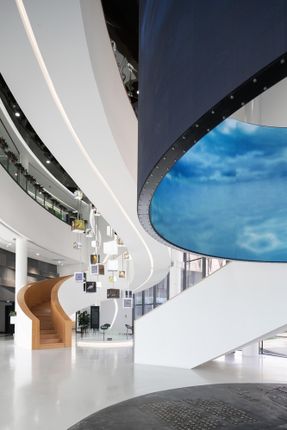Wetland Museum In Huailai
ARCHITECTS
Tenio
COPPER WORKS
Shanghai Huayuan New Composite Materials Co.ltd.
LANDSCAPE DESIGN
Tianjin Huafang Zhujing Environment Landscape Design Co.ltd.
CONSTRUCTION UNIT
Mcc Tiangong Group Co. Ltd
ARCHITECT
Jun Ren, Nan Jiang, Yingjun Fu, Runbo Guo, Ran Chen, Yang Di
STRUCTURE DESIGN
Zhiyong Wang, Lesa Meng
EQUIPMENT ENGINEERING
Bing Liu, Jian Chen, Hui Yang
CONSTRUCTION DRAWING DESIGN
Tenio Architecture And Engineering Co.ltd., Bcci
CURTAIN WALL DESIGN
Gasun Construction Group
EXHIBITION DESIGN
Shanghai Fengyuzhu Culture Technology Co.ltd.
PARK MANAGEMENT
Chinese Institute Of Urban Scientific Planning And Design
THE CLIENT
Huailai Forestry Bureau
PHOTOGRAPHS
Awesome
AREA
8446 m²
YEAR
2019
LOCATION
Zhangjiakou, China
CATEGORIES
Landscape Architecture, Museum
Text description provided by architect.
This wetland museum is located in the largest wetland near Beijing, which is the home of 40 species of resident birds and a pathway of 151 species of migratory birds.
The museum disseminates wetland knowledge to tourists, especially teenagers, and educates and trains popular science enthusiasts with the help of forestry administrations.
The overall goal of the project is to achieve a building that minimizes disturbance to the wetland and integrated into the nature, and includes three main goals respectively micro impact, zero-emission and full cycling.
The way to achieve the goal is to firstly use the annular floating strategy that elevates the building over the wetland, and then utilize low-energy building design, self-cycling equipment, and assembled construction.
PROCESS— Afull cycling museum of wetland education. The vulnerability of the environment in wetlands requires minimization of the output of buildings to nature. Starting from design, the museum realizes the full cycling of materials, energy, and water system.
The building uses the prefabricated steel structure, and realizes material cycling in the whole life cycle, from factory manufacturing to on-site installation and removal. It utilizes solar energy and air energy to realize energy cycling.
PLANET—Achieving friendliness to birds in the natural wetland by micro impact and zero emission. The building uses an elevated structure over the site to reduce the occupation of wetland as much as possible, and restores natural wetland within the site.
At the same time, the wetland landscape is compensated on the roof of the building, so that the net loss of wetland is zero.
An antibacterial copper plate is selected for the building skin, and this material will be gradually oxidized from golden yellow to copper green and integrated with the environment. The gap between the skin and the building and the exterior suspended ceiling will become the birds’ nests.
Based on to research results, the pattern of glass curtain wall is designed with 100x50mm grids that is sensitive to bird vision to prevent birds from hitting by mistake
Rainwater is recycled through the collection and reclaimed water treatment.
Considering that there is no sewage pipeline on the site, a mechanical + natural filtration and purification system is built for sewage treatment to realize zero sewage discharge to the wetland ecosystem.
PLACE—A building integrated into and adapted to the wetland environment. Considering the landscape environment of the wetland park, the building is arranged on the site in the form of a floating ring. Space and form take into account the common attention to people and creatures.
The courtyard connected with the nature and the elevated space allow birds, small animals and people to enter the semi-enclosed site in 24 hours, achieving symbiosis of the building and the environment.
The building corresponds to the huge scale of the environment with the overall floating horizontal form, and the sense of the rhythm of the copper skin corresponds to the texture of the green forest on the site.
From the perspective of carbon sink, the building reduces land occupation as much as possible. The elevated building returns the natural space to the wetland. The enclosed outdoor courtyard is connected with the natural site through the elevated layer. The outdoor environment keeps the natural ecology of the wetland as well as the tall pagoda trees and Chinese pine forests around the building.
The public space of the building forms a dramatic building space with the help of natural lighting, a colored photovoltaic corridor, and special-shaped main stairs.
The exhibition hall has vision contact with the natural landscape, making the vast landscape of the wetland park the most spectacular exhibit of the museum.


























